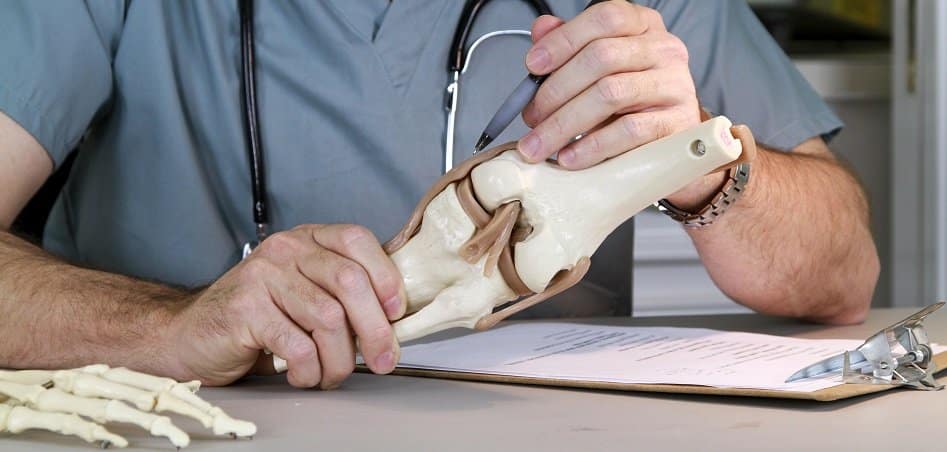There are few companies claiming to offer artificial intelligence solutions to orthopedics companies. We found that these solutions are intended to help orthopedics companies with at least one of the following business problems:
- Planning for Surgery
- Body Structure Segmentation for Medical Imaging
RSIP Vision appears to have found a purpose for machine vision in the orthopedics industry. It appears their machine learning algorithms work to differentiate body structures to create a 3D model from an X-ray or an MRI. Each structure in the X-ray or MRI is highlighted, including possible tumors. This approach to image processing would allow orthopedics companies to segment joints with multiple bones along with sections of cartilage between them. They can then use the 3D model to identify the problem and plan their surgical process.
Companies that claim to offer predictive analytics solutions are more common in the orthopedic space, but even that application seems nascent at this point in time. Currently, the AI software is used to predict complications and outcomes in orthopedic surgery, which would allow the surgeon to plan for the most success. OM1’s Medical Burden Index software makes predictions based on patient information from their healthcare provider. Medicrea’s UNiD Hub software can predict the outcome of surgery based on previous surgical records, as well as changes to the surgical procedure that could increase the chance of the best outcome.
What Business Leaders in Orthopedics Should Know
It appears rare for a company to offer AI software that caters exclusively to orthopedic surgeons. RSIP Vision, for example, offers machine vision solutions for various industries. Generally, diversifying in this way can reduce the attention that each individual sector receives when data scientists go to update the models offered to those sectors. This doesn’t mean that RSIP Vision’s orthopedics solution is likely to be inaccurate by any means, but in general, we like to see AI vendors that cater to only one or two industries.
Predictive Analytics solutions mostly concern orthopedic surgery and their possible results or complications. These vendors offer software that searches through medical records for indicators of success with treating certain diagnoses. They may factor in the overall burden the disorder causes for the patient, the resources required to perform the required surgery, and notes on successful procedures on previous patients. Companies offering this type of software tend to claim their software is best used for planning surgeries effectively. This makes sense given the software makes predictions of the steps the surgeon should take for performing surgery on specific patients.
OM1’s Chief Technology Officer, Phillip Wickline, is among the few C-level staff at the companies covered in this report that has a decent likelihood of being able to work with AI. He and a few others have Master’s degrees in Computer Science at schools known for their AI programs. In Wickline’s case, that’s Carnegie Mellon, which boasts perhaps the most renowned AI curriculum in the world. That said, the companies covered in this report employ data scientists with Master’s or a PhD in other scientific or statistical fields.
Planning for Surgery
OM1
OM1 offers software called OM1 Medical Burden Index (OMBI), which it claims can help healthcare providers predict the outcome of surgical operations and create a planning model for those operations using predictive analytics. The OMBI determines how much a patient’s medical ailments or diseases are affecting their life.
The evaluation is a combined measurement of the burden placed on the patient by all of their medical problems and is scored from 1-1000. This is called the OMBI Score, and was generated from an analysis of over 200 million patients across the U.S. OM1 claims the OMBI score is a strong predictor of the resources a patient will use in the future and their mortality. According to OM1’s website, the American Heart Association found that the OMBI Score worked better than an established competitor called the LACE Index.
Below is a screenshot from the company’s website that appears to show what the OMBI software looks like on a tablet:

The company claims healthcare providers can integrate the software into databases for clinical data storage, such as a database for electronic medical records.
We can infer the machine learning model behind the software was trained on thousands of electronic medical and health records. These records would have to include the severity of any pain the patient is in, and how debilitating their symptoms are. The data would then be run through the software’s machine learning algorithm. This would have trained the algorithm to discern which data points correlate to the highest severity of disease burden in patients. These severities could refer to being bedridden, paralyzed, or unable to speak. Each factor that debilitates the patient in their daily life would be given a numerical value, and then run through OM1’s formula to determine the OMBI Score.
The software would then be able to predict possible complications with a patient’s disease and the amount of resources the patient will use in the future. This may or may not require the user to upload information about the patient’s health insurance or the resource management policies of the medical facility they are visiting into the software beforehand.
OM1 doesn’t provide many explanatory materials for its software. We could not find a demonstration video available for it, for example. The company also doesn’t list any case studies on its website nor any major business clients. They have, however, raised $36 million and are backed by Polaris Partners and General Catalyst
Phillip Wickline is CTO at OM1. He holds an MS in Computer Science from Carnegie Mellon. Previously, Wickline served as CEO at Zaius.
Medicrea
Medicrea offers software called UNiD HUB, which it claims can help healthcare providers create models of surgical procedures to ensure accurate operations using predictive analytics.
Medicrea’s UNiD ASI platform consists of three services that the company claims can support surgeons when performing spinal surgeries, which are called “UNiD LAB,” “UNiD TEK,” and “UNiD HUB.” UNiD LAB is a consultation service with which providers can speak with Medicrea’s staff, which the company refers to as “biomedical engineers.” The service helps clients find new surgical strategies and simulate them to see what will work best for a given case.
UNiD TEK is what Medicrea calls their selection of surgical implants that are customized to the surgical case plan. They provide spinal rods and other orthopedic implants that are made specifically for each patient. Medicrea claims the UNiD TEK implants are optimized for the surgery they are made for and that they are delivered to the surgical location prior to surgery. This would likely require extensive consultation work about the patient in question.
Below is a screenshot from the company’s website showing what their software might look like on desktop and mobile:

We can infer the machine learning model behind the software was trained on tens of thousands of medical documents that report on different surgeries, including any complications that occurred during or as a result of the surgery. The data would then be run through the software’s machine learning algorithm. This would have trained the algorithm to discern which data points correlate to the most successful surgeries. The software would then be able to predict whether an operation would be successful and the best course of action to reach a positive outcome for a patient.
Like OM1, Medicrea seems a bit lacking in explanatory materials. We could not find a demonstrative video showing how its software works, and it does not make available any case studies reporting success with its software. Moreover, the company does not list any major business clients. They have, however, raised $95.8 million and are backed by Athyrium Capital Management, LP
Thomas Mosnier is CTO at Medicrea. He holds a PhD in Biomechanics from École Nationale Supérieure d’Arts et Métiers. Previously, Mosnier served as Research Engineer at Biomechanics Laboratory of ENSAM.
Body Structure Segmentation for Medical Imaging
RSIP Vision
RSIP Vision offers machine learning algorithms for custom software which it claims can help healthcare providers image and segment bones for surgery using machine vision.
Founded in 1987, RSIP Vision labels itself a “global leader in computer vision and machine learning.” Their work in machine vision can be found in the automotive, agricultural, and optical character recognition(OCR) spaces. However, their most robust field of expertise appears to be medical image processing and segmentation. In addition to orthopedic surgery, RSIP Vision has used its machine learning algorithms and image processing software in cardiology, ophthalmology, and pulmonology. Outside of these specific spaces, the company has also worked on numerous projects involving segmentation of brain tumors, the prostate gland, the kidneys, and automatic segmentation of tumor cells.
Below is a short 2-minute video demonstrating how RSIP Vision’s custom software can also image and segment organs and their parts from an MRI:
RSIP Vision does not make available any case studies reporting success with their software, but they do list Medivision and the BIRD Foundation as some of their past clients.
We can infer the machine learning model behind the software was trained on thousands of x-rays showing patients’ bones from various angles including where bones overlap and in various lighting conditions. These images would have been labeled by the type of bone or bones shown in the x-ray, as well as by relative location to each other. These labeled images would then be run through the software’s machine learning algorithm. This would have trained the algorithm to discern the sequences and patterns of 1’s and 0’s that, to the human eye, form the image of a patient’s bone as displayed in an x-ray.
The user could then upload an x-ray of an area of the body where bones overlap, such as the knee joint that is not labeled into their custom software from RSIP Vision. Also, the software will likely require volumetric data on the part of the body being imaged, in order to create an image accurate to the volume of the bones and closeby cartilage. The algorithm behind the software would then be able to determine the shape of each bone by cross-referencing the images with the volumetric data. The system then shows a human employee a computer-generated 3D image of the bones depicted in the x-ray that reflects the volume and placement of each bone.
Ilya Kovler is CTO of Medical Imaging at RSIP Vision. He holds an MS in computer science from The Hebrew University. Previously, Kovler served as Software Engineer at Intel.
Header Image Credit: Healthy Things Online















